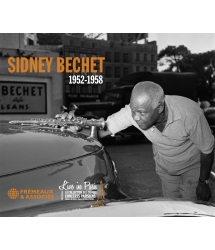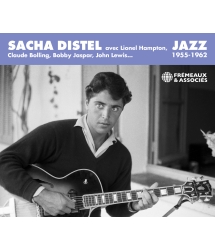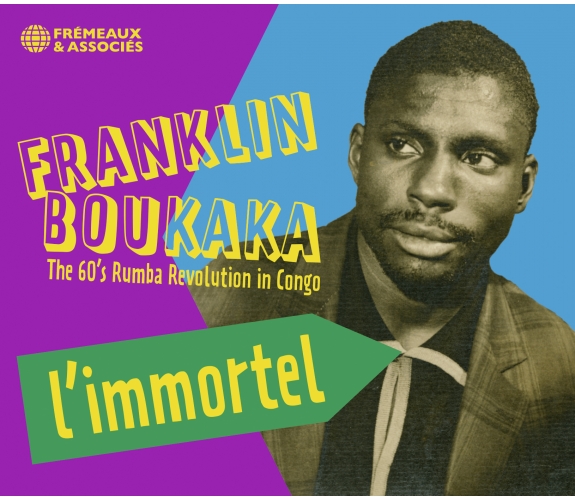- Our Catalog
- Philosophy
- Philosophers of the 20th century and today
- History of Philosophy (PUF)
- Counter-History and Brief Encyclopedia by Michel Onfray
- The philosophical work explained by Luc Ferry
- Ancient thought
- Thinkers of yesterday as seen by the philosophers of today
- Historical philosophical texts interpreted by great actors
- History
- Books (in French)
- Social science
- Historical words
- Audiobooks & Literature
- Our Catalog
- Jazz
- Blues
- Rock - Country - Cajun
- French song
- World music
- Africa
- France
- Québec / Canada
- Hawaï
- West Indies
- Caribbean
- Cuba & Afro-cubain
- Mexico
- South America
- Tango
- Brazil
- Tzigane / Gypsy
- Fado / Portugal
- Flamenco / Spain
- Yiddish / Israel
- China
- Tibet / Nepal
- Asia
- Indian Ocean / Madagascar
- Japan
- Indonesia
- Oceania
- India
- Bangladesh
- USSR / Communist songs
- World music / Miscellaneous
- Classical music
- Composers - Movie Soundtracks
- Sounds of nature
- Our Catalog
- Youth
- Philosophy
- News
- How to order ?
- Receive the catalog
- Manifesto
- Dictionnary











- Our Catalog
- Philosophy
- Philosophers of the 20th century and today
- History of Philosophy (PUF)
- Counter-History and Brief Encyclopedia by Michel Onfray
- The philosophical work explained by Luc Ferry
- Ancient thought
- Thinkers of yesterday as seen by the philosophers of today
- Historical philosophical texts interpreted by great actors
- History
- Books (in French)
- Social science
- Historical words
- Audiobooks & Literature
- Our Catalog
- Jazz
- Blues
- Rock - Country - Cajun
- French song
- World music
- Africa
- France
- Québec / Canada
- Hawaï
- West Indies
- Caribbean
- Cuba & Afro-cubain
- Mexico
- South America
- Tango
- Brazil
- Tzigane / Gypsy
- Fado / Portugal
- Flamenco / Spain
- Yiddish / Israel
- China
- Tibet / Nepal
- Asia
- Indian Ocean / Madagascar
- Japan
- Indonesia
- Oceania
- India
- Bangladesh
- USSR / Communist songs
- World music / Miscellaneous
- Classical music
- Composers - Movie Soundtracks
- Sounds of nature
- Our Catalog
- Youth
- Philosophy
- News
- How to order ?
- Receive the catalog
- Manifesto
- Dictionnary
1949-1962
Sammy Davis Jr.
Ref.: FA5864
Artistic Direction : OLIVIER JULIEN
Label : FREMEAUX & ASSOCIES
Total duration of the pack : 3 hours 39 minutes
Nbre. CD : 3
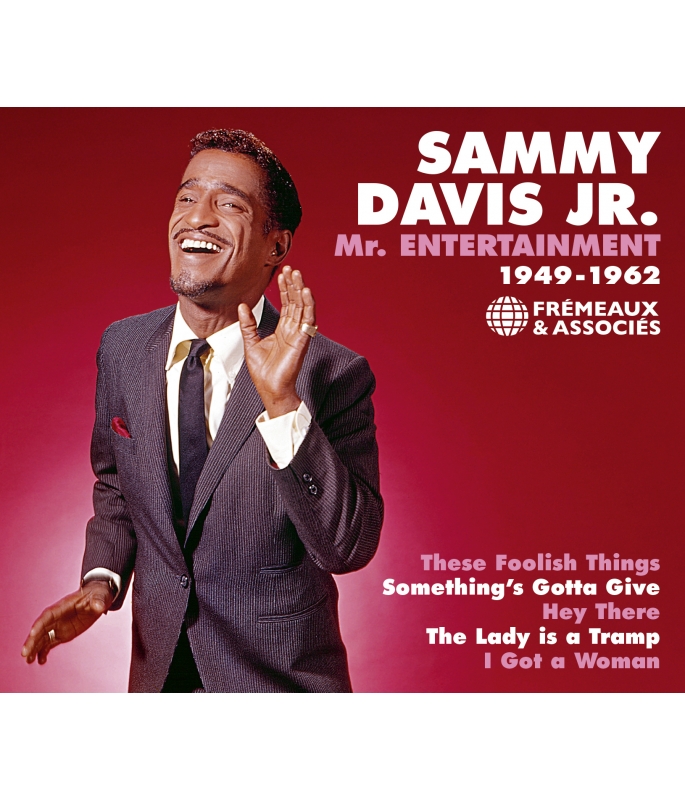
1949-1962
- - Sélection Noël - Le Monde
- - Choc Classica
He was born in Harlem, and his parents were music hall artists. Sammy Davis Jr. would learn how to do everything: sing, perform, dance, act... He had such an unmistakeable voice, and together with his look, his “attitude” and his unshakable feeling for putting on a show, it made him a complete artist and he became one of the most famous crooners of the 20th century. Prepared by Olivier Julien, this 3CD anthology throws light on recordings by the man they called “Mr. Entertainment.” He was no doubt the first black Superstar in America, a figure whose peers included Frank Sinatra and Dean Martin.
Patrick Frémeaux
CD1
1 - Bebop the Beguine 2’47
2 - Can’t You See I’ve Got the Blues 2’46
3 - Hey There 2’46
4 - Because of You (part 1) 2’44
5 - Because of You (part 2) 2’46
6 - Glad to Be Unhappy 3’04
7 - The Red Grapes 2’47
8 - Love (Your Magic Spell is Everywhere) 2’09
9 - The Birth of the Blues 3’17
10 - I’ll Know 3’01
11 - Adelaide 2’49
12 - The Lonesome Road 2’09
13 - September Song 2’52
14 - These Foolish Things 4’04
15 - Six Bridges to Cross 3’01
16 - All of you 2’40
17 - Stan’ up and Fight 4’08
18 - Easy to Love 2’22
19 - My Funny Valentine 3’08
20 - Something’s Gotta Give 2’03
21 - You do Something to Me 2’17
22 - Love Me or Leave Me 2’58
23 - The Man with the Golden Arm 3’10
24 - In a Persian Market 2’31
25 - Five 2’16
26 - You’re Sensational 3’00
27 - Don’t let Her Go 2’57
CD2
1 - Love Me or Leave Me 2’56
2 - Frankie and Johnny 3’17
3 - Circus 3’05
4 - That Old Black Magic 3’18
5 - Too Close for Comfort 2’18
6 - Guess I’ll Hang my Tears Out to Dry 4’40
7 - New York’s My Home 3’13
8 - Just One of Those Things 2’50
9 - Earthbound 3’09
10 - Dangerous 2’52
11 - All About Love 2’35
12 - The Gypsy in My Soul 2’52
13 - Begin the Beguine 3’23
14 - You’re the Top (avec Carmen Mc Rae) 3’03
15 - Happy to Make Your Acquaintance 3’12
16 - Baby, it’s Cold Outside (avec Carmen Mc Rae) 3’13
17 - The Golden Key 3’01
18 - Long Before I Knew You 2’59
19 - French Fried Potatoes & Ketchup 2’15
20 - Goodbye so Long I’m Gone 3’02
21 - Someone to Watch Over Me 3’23
22 - All the Way 2’58
23 - Night and Day 2’28
24 - On a Slow Boat to China 2’36
25 - When I Fall in Love 3’28
CD3
1 - They Can’t Take that Away from Me 2’04
2 - I Can’t Get Started 3’27
3 - I Ain’t Gonna Change 2’16
4 - Song and Dance Man 3’07
5 - No Fool Like an Old Fool 2’40
6 - Unspoken 3’07
7 - You’d Be so Nice To Come Home To 3’09
8 - Pennies From Heaven 4’24
9 - Love Letters 4’17
10 - It’s Magic 3’25
11 - I’ve Heard that Song Before 3’39
12 - I Loves You Porgy (avec Carmen Mc Rae) 3’49
13 - There’s A Boat Dat’s Leavin’ Soon for New York 2’16
14 - The Lady Is A Tramp 4’22
15 - What Kind of Fool Am I 3’23
16 - Gonna Build a Mountain 2’23
17 - Once in a Lifetime 2’10
18 - Someone Nice Like You 2’24
19 - As Long as She Needs Me 3’05
20 - Let’s Face the Music and Dance 2’23
21 - Deed I Do 2‘11
22 - Falling in Love Again (I can’t help it) 3’26
DIRECTION ARTISTIQUE : OLIVIER JULIEN
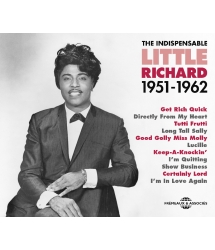
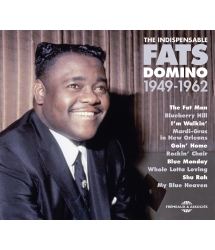
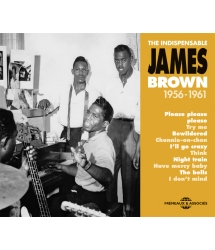
JAMES BROWN
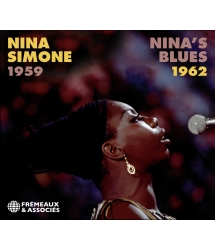
COMPLETE 1959-1962




-
PisteTitleMain artistAutorDurationRegistered in
-
1Bebop the BeguineSammy Davis JrDick Hazard, Bill Jordan00:02:471949
-
2Can’t You See I’ve Got the BluesSammy Davis JrSammy Davis Jr, Jeff Dane00:02:461949
-
3Hey ThereSammy Davis JrRichard Adler, Jerry Ross00:02:461954
-
4Because of You (part 1)Sammy Davis JrArthur Hammestein, Dudley Wilkinson00:02:441954
-
5Because of You (part 2)Sammy Davis JrArthur Hammestein, Dudley Wilkinson00:02:461954
-
6Glad to Be UnhappySammy Davis JrLaurenz Hart00:03:041954
-
7The Red GrapesSammy Davis JrRoos Bagdasarian, Frank Cady00:02:471954
-
8Love (Your Magic Spell is Everywhere)Sammy Davis JrEdmund Goulding, Elsie Janis00:02:091954
-
9The Birth of the BluesSammy Davis JrBuddy DeSylva, Lew Brown00:03:171954
-
10I’ll KnowSammy Davis JrFranck Loesser00:03:011954
-
11AdelaideSammy Davis JrFranck Loesser00:02:491954
-
12The Lonesome RoadSammy Davis JrNathaniel Shilkert, Gene Austin00:02:091955
-
13September SongSammy Davis JrMaxwell Henderson00:02:521955
-
14These Foolish ThingsSammy Davis JrHolt Marvell00:04:041955
-
15Six Bridges to CrossSammy Davis JrJeff Chandler00:03:011955
-
16All of youSammy Davis JrCole Porter00:02:401955
-
17Stan’ up and FightSammy Davis JrGeorges Bizet, Oscar Hammerstein II00:04:081955
-
18Easy to LoveSammy Davis JrCole Porter00:02:221955
-
19My Funny ValentineSammy Davis JrLaurenz Hart00:03:081955
-
20Something’s Gotta GiveSammy Davis JrJohnny Mercer00:02:031955
-
21You do Something to MeSammy Davis JrCole Porter00:02:171955
-
22Love Me or Leave MeSammy Davis JrWalter Donaldson00:02:581955
-
23The Man with the Golden ArmSammy Davis JrJames Van Heten00:03:101955
-
24In a Persian MarketSammy Davis JrAlbert W. Ketelbey, Mack David00:02:311955
-
25FiveSammy Davis JrBilly Martin, Larry Martin00:02:161956
-
26You’re SensationalSammy Davis JrCole Porter00:03:001956
-
27Don’t let Her GoSammy Davis JrAbner Silver00:02:571956
-
PisteTitleMain artistAutorDurationRegistered in
-
1Love Me or Leave MeSammy Davis JrWalter Donaldson00:02:561955
-
2Frankie and JohnnySammy Davis JrSammy Cahn00:03:171956
-
3CircusSammy Davis JrLouis Alter00:03:051956
-
4That Old Black MagicSammy Davis JrJohnny Mercer00:03:181957
-
5Too Close for ComfortSammy Davis JrJerry Bock, Larry Holofcener00:02:181956
-
6Guess I’ll Hang my Tears Out to DrySammy Davis JrSammy Cahn, Jule Styrne00:04:401958
-
7New York’s My HomeSammy Davis JrGordon Jenkins00:03:131956
-
8Just One of Those ThingsSammy Davis JrCole Porter00:02:501956
-
9EarthboundSammy Davis JrJack Taylor, Clive Richardson00:03:091956
-
10DangerousSammy Davis JrBill Mure, Hall Hackady00:02:521956
-
11All About LoveSammy Davis JrJeff Myrow, Mack Gordon00:02:351956
-
12The Gypsy in My SoulSammy Davis JrMoe Jaffe00:02:521957
-
13Begin the BeguineSammy Davis JrCole Porter00:03:231957
-
14You’re the Top (avec Carmen Mc Rae)Sammy Davis JrCole Porter00:03:031957
-
15Happy to Make Your AcquaintanceSammy Davis JrFranck Loesser00:03:121957
-
16Baby, it’s Cold Outside (avec Carmen Mc Rae)Sammy Davis JrFranck Loesser00:03:131957
-
17The Golden KeySammy Davis JrDon Marcotte, Abner Spector00:03:011957
-
18Long Before I Knew YouSammy Davis JrBetty Comden, Adolph Green00:02:591957
-
19French Fried Potatoes & KetchupSammy Davis JrRobbie Kirk00:02:151957
-
20Goodbye so Long I’m GoneSammy Davis JrRobbie Kirk00:03:021957
-
21Someone to Watch Over MeSammy Davis JrIra Gershwin00:03:231958
-
22All the WaySammy Davis JrJames Van Heusen00:02:581958
-
23Night and DaySammy Davis JrCole Porter00:02:281958
-
24On a Slow Boat to ChinaSammy Davis JrFranck Loesser00:02:361958
-
25When I Fall in LoveSammy Davis JrEdward Heyman00:02:281958
-
PisteTitleMain artistAutorDurationRegistered in
-
1They Can’t Take that Away from MeSammy Davis JrIra Gershwin00:02:041958
-
2I Can’t Get StartedSammy Davis JrIra Gershwin00:03:271958
-
3I Ain’t Gonna ChangeSammy Davis JrJerry Foster, Wilburn Rice00:02:161958
-
4Song and Dance ManSammy Davis JrDavid Mann, Bob Hilliard00:03:071958
-
5No Fool Like an Old FoolSammy Davis JrJoseph Myer, Joseph McCarthy00:02:401958
-
6UnspokenSammy Davis JrMack Discant00:03:071959
-
7You’d Be so Nice To Come Home ToSammy Davis JrCole Porter00:03:091959
-
8Pennies From HeavenSammy Davis JrJohnny Burke00:04:241959
-
9Love LettersSammy Davis JrEdward Heyman00:04:171959
-
10It’s MagicSammy Davis JrSammy Cahn, Jule Styrne00:03:251959
-
11I’ve Heard that Song BeforeSammy Davis JrSammy Cahn, Jule Styrne00:03:391959
-
12I Loves You Porgy (avec Carmen Mc Rae)Sammy Davis JrIra Gershwin, Dubose Heyward00:03:491959
-
13There’s A Boat Dat’s Leavin’ Soon for New YorkSammy Davis JrIra Gershwin, Dubose Heyward00:02:161959
-
14The Lady Is A TrampSammy Davis JrLaurenz Hart00:04:221960
-
15What Kind of Fool Am ISammy Davis JrLeslie Briscure, Anthony Newley00:03:231962
-
16Gonna Build a MountainSammy Davis JrLeslie Briscure, Anthony Newley00:02:231962
-
17Once in a LifetimeSammy Davis JrLeslie Briscure, Anthony Newley00:02:101962
-
18Someone Nice Like YouSammy Davis JrLeslie Briscure, Anthony Newley00:02:241962
-
19As Long as She Needs MeSammy Davis JrLionel Bart00:03:051961
-
20Let’s Face the Music and DanceSammy Davis JrIrving Berlin00:02:231961
-
21Deed I DoSammy Davis JrWalter Hirsch00:02:111961
-
22Falling in Love Again (I can’t help it)Sammy Davis JrFriedrich Hollander00:03:261961
SAMMY
DAVIS JR.
Mr. Entertainment
1949-1962
These Foolish Things
Something’s Gotta Give
Hey There
The Lady is a Tramp
I Got a Woman
Né à Harlem de parents artistes de music-hall, Sammy Davis Jr. savait tout faire : chanter, jouer, danser... Sa voix si reconnaissable, son look, son attitude et son inébranlable sens du show ont fait de cet artiste touche à tout, l’un des crooners les plus célèbres du XXe siècle. Réalisée par Olivier Julien, cette anthologie 3 CD met en lumière les enregistrements de celui que l’on surnommait « Mr. Entertainment ». Sans doute la première superstar noire aux États-Unis, compère de Frank Sinatra et Dean Martin. Patrick Frémeaux
He was born in Harlem, and his parents were music hall artists. Sammy Davis Jr. would learn how to do everything: sing, perform, dance, act... He had such an unmistakeable voice, and together with his look, his “attitude” and his unshakable feeling for putting on a show, it made him a complete artist and he became one of the most famous crooners of the 20th century. Prepared by Olivier Julien, this 3CD anthology throws light on recordings by the man they called “Mr. Entertainment.” He was no doubt the first black Superstar in America, a figure whose peers included Frank Sinatra and Dean Martin. Patrick Frémeaux
CD1
1 - Bebop the Beguine 2’47
2 - Can’t You See I’ve Got the Blues 2’46
3 - Hey There 2’46
4 - Because of You (part 1) 2’44
5 - Because of You (part 2) 2’46
6 - Glad to Be Unhappy 3’04
7 - The Red Grapes 2’47
8 - Love (Your Magic Spell is Everywhere) 2’09
9 - The Birth of the Blues 3’17
10 - I’ll Know 3’01
11 - Adelaide 2’49
12 - The Lonesome Road 2’09
13 - September Song 2’52
14 - These Foolish Things 4’04
15 - Six Bridges to Cross 3’01
16 - All of you 2’40
17 - Stan’ up and Fight 4’08
18 - Easy to Love 2’22
19 - My Funny Valentine 3’08
20 - Something’s Gotta Give 2’03
21 - You do Something to Me 2’17
22 - Love Me or Leave Me 2’58
23 - The Man with the Golden Arm 3’10
24 - In a Persian Market 2’31
25 - Five 2’16
26 - You’re Sensational 3’00
27 - Don’t let Her Go 2’57
CD2
1 - Love Me or Leave Me 2’56
2 - Frankie and Johnny 3’17
3 - Circus 3’05
4 - That Old Black Magic 3’18
5 - Too Close for Comfort 2’18
6 - Guess I’ll Hang my Tears Out to Dry 4’40
7 - New York’s My Home 3’13
8 - Just One of Those Things 2’50
9 - Earthbound 3’09
10 - Dangerous 2’52
11 - All About Love 2’35
12 - The Gypsy in My Soul 2’52
13 - Begin the Beguine 3’23
14 - You’re the Top (avec Carmen Mc Rae) 3’03
15 - Happy to Make Your Acquaintance 3’12
16 - Baby, it’s Cold Outside (avec Carmen Mc Rae) 3’13
17 - The Golden Key 3’01
18 - Long Before I Knew You 2’59
19 - French Fried Potatoes & Ketchup 2’15
20 - Goodbye so Long I’m Gone 3’02
21 - Someone to Watch Over Me 3’23
22 - All the Way 2’58
23 - Night and Day 2’28
24 - On a Slow Boat to China 2’36
25 - When I Fall in Love 3’28
CD3
1 - They Can’t Take that Away from Me 2’04
2 - I Can’t Get Started 3’27
3 - I Ain’t Gonna Change 2’16
4 - Song and Dance Man 3’07
5 - No Fool Like an Old Fool 2’40
6 - Unspoken 3’07
7 - You’d Be so Nice To Come Home To 3’09
8 - Pennies From Heaven 4’24
9 - Love Letters 4’17
10 - It’s Magic 3’25
11 - I’ve Heard that Song Before 3’39
12 - I Loves You Porgy (avec Carmen Mc Rae) 3’49
13 - There’s A Boat Dat’s Leavin’ Soon for New York 2’16
14 - The Lady Is A Tramp 4’22
15 - What Kind of Fool Am I 3’23
16 - Gonna Build a Mountain 2’23
17 - Once in a Lifetime 2’10
18 - Someone Nice Like You 2’24
19 - As Long as She Needs Me 3’05
20 - Let’s Face the Music and Dance 2’23
21 - Deed I Do 2‘11
22 - Falling in Love Again
(I can’t help it) 3’26
Sammy Davis Jr. “Mr. Entertainment” 1949-1962
Par Olivier Julien
|
S |
ammy Davis Jr. était connu pour savoir tout faire : chanter, danser, jouer la comédie et de nombreux instruments en plus d’un jeu de scène teinté d’humour caustique. Pendant soixante ans, de ses débuts d’enfant star à l’age de quatre ans à la fin des années 20, jusqu’à sa mort en 1990 à l’age de soixante-quatre ans, il n’a jamais usurpé son titre de Mr. Entertainment (Monsieur divertissement) Lorsqu’il ne faisait pas parler de lui pour ses performances scéniques, il faisait les gros titres de la presse comme membre fondateur du Rat Pack aux cotés de ses compères superstars Frank Sinatra et Dean Martin. Sammy Davis Jr. dans les années 50 et 60 contribua à faire évoluer les mentalités sur le racisme notamment à Las Vegas où il se produisait régulièrement,
Samuel George Sammy Davis Jr.. naît dans le quartier de Harlem, à Manhattan, à New York. Il est le fils d’Elvera Sanchez, une danseuse d’origine cubaine et afro-américaine et de Sammy Davis Sr., star du vaudeville d’origine afro-américaine. Le couple gagne sa vie en jouant dans des comédies populaires au théâtre, Sammy est alors élevé par sa grand-mère paternelle. Il n’est âgé que de trois ans lorsque ses parents divorcent. Pour ne pas perdre la garde de son fils, Sammy Sr. l’emmène avec lui en tournée. C’est dans la troupe de Will Masin dont fait partie son père que Sammy Davis Jr. apprend à danser, jouer la comédie et chanter. C’est avec Howard M. Colbert Jr qu’ils forment le Will Mastin trio. Colbert devient son professeur et il l’appellera « son oncle ». Pour la première fois Sammy apparaît dans un film en 1933, Rufus Jones for président, dans lequel il danse. Lorsque Colbert est enrôlé dans les troupes américaines en Décembre 1941, Sammy, alors âgé de seize ans le remplace au sein du trio jusqu’à son propre départ à l’armée. Pour la première fois, il est confronté aux problèmes de racisme, petit et râblé, il était souvent la cible d’attaques physiques de la part de ses acolytes costauds et blancs et les officiers l’affectaient aux tâches les plus ingrates alors que son père et Howard M. Colbert Jr l’avaient toujours protégé du racisme ambiant. « La nuit, le monde était différent. Ce n'était plus une question de couleur. C'est là que je me suis rendu compte que mon père et Will m'avaient protégé jusque-là. Ils avaient espéré que je puisse échapper aux moqueries et à la haine. Je leur en étais reconnaissant, mais ils avaient eu tort. C'était comme si j'étais passé par une porte battante pendant dix-huit ans, une porte qu'ils avaient secrètement toujours laissé ouverte ». Dans l’armée, il intègre une unité spéciale de divertissement et se rend compte pendant ses prestations que la foule oublie vite la couleur de l’acteur. A son retour du service militaire le trio se reforme et devient célèbre à Las Vegas, Sammy est alors surnommé le gamin du milieu. Il est repéré par la maison de disques Decca et enregistre un premier album en 1954 : Starring Sammy Davis Jr.. Le 19 Novembre 1954, alors qu’il se rend à l’enregistrement du générique du film de Joseph Pevney, avec Tony Curtis, Six Bridges to Cross (La Police était au rendez-vous) , il est victime sur la route de Los Angeles sur un passage à niveau de la Route 66 à hauteur de San Bernardino (Californie), d’un très grave accident de voiture. Il y perd son œil gauche et portera un œil de verre jusqu’à la fin de sa vie. Durant sa longue hospitalisation, il se convertit au judaïsme, établissant un parallèle avec la condition des noirs américains. Un deuxième album Just for lovers paraît en 1955 toujours chez Decca. En 1956, alors que sa carrière décolle, il décroche un second rôle à Broadway dans la comédie musicale Mr. Wonderful aux côtés de son père et de Will Mastin. Le spectacle est un succès, représenté près de quatre cent fois et un disque est édité. La même année, il enregistre un album supplémentaire Here’s looking at you. Il devient une tête d’affiche du casino Frontier à Las Vegas, il n’est cependant pas autorisé à séjourner à l’hôtel ou à boire un verre au bar parce qu’ils refusent la clientèle noire. Durant la fin des années 50 Sammy Davis Jr. apparaît dans les films Anna Lacusta, Porgy and Bess et Ocean’s eleven (L’Inconnu de Las Vegas). C’est durant le tournage d’Ocean’s eleven en 1960, qu’il fait la connaissance et se lie d’amitié avec Frank Sinatra. Avec Dean Martin, Peter Lawford et Joey Bishop, ils deviennent connus sous le nom de Rat Pack. La même année, il se marie avec l’actrice d’origine suédoise May Britt. Ils auront une fille biologique et adopteront deux garçons. Le mariage interracial créa la controverse ; interdit à cette époque dans trente et un états, ce n’est qu’en 1967 qu’un arrêté de la cour suprême abolira cette loi. Bien qu’étant probablement l’artiste noir le plus connu aux États-Unis en 1961, il est écarté des convives lorsque Frank Sinatra arrange que le Rat Pack se produise lors d’un bal inaugural pour l’investiture du président Kennedy. C’est en partie à la suite de cet incident que Sammy Davis Jr. se liera d’amitié avec le rival politique de Kennedy, Richard Nixon. Bien qu’ayant rejoint le parti républicain, il supporte activement le mouvement pour les droits à l’égalité raciale pendant les années 60 apparaissant publiquement avec le Dr. Martin Luther King Jr et récoltant des milliers de dollars pour venir en aide aux activistes du « civil rights ». Il devient le premier artiste noir à signer avec la maison de disques Reprise pour qui Frank Sinatra enregistre également. Le Rat Pack sort des dizaines d’albums et tourne de nombreux films de qualités inégales, parmi lesquels Robin and the Seven Hoods (Les Sept Voleurs de Chicago) en 1964. De 1960 à 1966, la troupe joue à guichets fermés dans toute l’Amérique avec un spectacle mêlant musique et comédie. Le Sands Hotel de Las Vegas dont Frank Sinatra est l’un des propriétaires devient le quartier général du Rat Pack et voit défiler certaines des plus grandes célébrités et hommes politiques des années 60. Alors que Las Vegas est connue majoritairement pour ses casinos, ils en font un haut point du divertissement. Dans ses différentes autobiographies, Sammy décrit un style de vie dissolue, où se mêlent alcoolisme, cocaïne et femmes. Il fait également état de problèmes financiers réguliers. En 1960, il est nommé pour le Grammy award du disque de l’année pour son titre What kind of fool am I ? Il joue également dans des films en dehors du Rat Pack, notamment dans A man called Adam dans lequel il tient le rôle principal face à Louis Amstrong. En 1966, il décroche son propre show télévisé The Sammy Davis Jr. show. Il divorce de May Britt en 1968 et se marie deux années plus tard à Altovise Gore, danseuse dans la comédie musicale Golden boy dont il est la vedette. Bien qu’étant initialement un succès, des tensions internes, des problèmes de production et des mauvaises critiques amenèrent à une fin prématurée. On reprocha notamment à Sammy de jouer un rôle initialement écrit pour un blanc et reçoit même des lettres de menaces. Il joue un rôle inoubliable en 1969 dans le film de Bob Fosse Sweet charity aux côtés de Shirley MacLaine. En 1972 il décroche un tube et devient numéro un avec The candy man qui lui vaut une nomination aux Grammy awards, cette même année il cause la controverse en accolant Richard Nixon durant la convention du parti républicain à Miami. De 1975 à 1977, il anime le show télévisé Sammy and company. Sammy Davis Jr. fait son retour à Broadway en 1978 avec Stop the world – I want to get off. Il apparaît en 1981 dans The cannonball run avec Burt Reynolds et Roger Moore et en 1989 dans Tap aux côtés de Gregory Hines. Il est un invité régulier des shows télé dont The tonight show, The Carol Burnett show, All in the family, The Jeffersons et apparaît également dans des feuilletons dont il est l’un des premiers à avouer qu’il en est friand : General hospital et One life to live.
Il part pour une tournée mondiale en 1989 avec Frank Sinatra et Liza Minnelli. Fumeur invétéré, il est atteint d’un cancer de la gorge et meurt à Beverly Hills en Californie en mai 1990.
Olivier Julien
© Frémeaux & Associés 2023
Sammy Davis Jr. “Mr. Entertainment” 1949-1962
|
S |
by Olivier Julien
ammy Davis Jr. had a reputation for knowing how to do everything: sing, dance, perform, play different instruments, not to mention the fact that his stage persona was tinged with a caustic sense of humour. For six decades – from his beginnings at the end of the twenties (as a child star aged four), up until his death in 1990 at the age of 64, he never lost his justified title as Mr. Entertainment. When he wasn’t on the front pages because of his stage exploits, he still made the headlines as a founder-member of the notorious “Rat Pack” alongside his superstar cronies Frank Sinatra and Dean Martin. In the fifties and sixties, Sammy Davis Jr. contributed to improve American mentality with regard to racism, notably in Las Vegas where he made regular appearances.
Samuel George Sammy Davis Jr. was born in Harlem, on Manhattan Island, New York. His mother was Elvera Sanchez, a Cuban dancer of Afro-American origin, and his father, Sammy Davis Sr., also an Afro-American, was a vaudeville star. The parents of Sammy Junior earned a living in theatres with appearances in popular comedies, and Sammy was raised by his paternal grandmother. He was only three when his parents divorced, and his father, to keep custody of his son, took Sammy Jr. on tour with him. Sammy Sr. was in the troupe led by Will Mastin, and it was there that Junior learned how to sing, dance, and play the actor. Together with Howard M. Colbert Jr. he formed the Will Mastin Trio and Colbert would become his teacher (Jr. called him “uncle”). The first time Sammy appeared on the screen was in 1933 (dancing in the film Rufus Jones for President). When Colbert was drafted into the U.S. Army in December 1941, Sammy was aged 16 and he replaced Colbert in the trio until he entered the draft in turn. Once in uniform he faced the problem of racism for the first time, and his small, unimposing stature led him to become a target for physical attacks from bigger, white fellow soldiers, while officers placed him on degrading duties. Up until then he had always been shielded from racism by his father and Howard M. Colbert Jr... “Overnight the world looked different. It wasn’t one color any more. I could see the protection I’d gotten all my life from my father and Will. I appreciated their loving hope that I’d never need to know about prejudice and hate, but they were wrong. It was as if I’d walked through a swinging door for 18 years, a door which they had always secretly held open.” In the Army he joined an entertainment-unit called “Special Services” where he learned during his performances that a crowd quickly forgot an actor’s color. After his release from the military the trio was re-formed, and they became famous in Las Vegas where Sammy was known as “the neighbourhood kid”. Decca’s talent scouts spotted him and recorded his first album for the label in 1954, “Starring Sammy Davis Jr.” On 19 November that year, while on his way to a session to record the title theme for a Joseph Pevney film with Tony Curtis, “Six Bridges to Cross,” the car he was travelling in was involved in a serious accident at a railroad crossing in San Bernardino, California. Sammy lost his left eye as a result, and had to wear a glass replacement for the rest of his life. He spent a long time in hospital, converting to Judaism and establishing a parallel with the condition of black Americans. A year later, a second album was released for Decca, “Just for lovers,” and then in 1956, when his career was taking off, he obtained a second Broadway role in the musical Mr. Wonderful alongside his father and Will Mastin. The show was a hit and there were almost four hundred performances, plus a record release. He also recorded the album “Here’s looking at you”. Sammy would top the bill at the Frontier casino in Vegas but didn’t have the right to a room at the hotel or a drink in the bar: black customers were banned.
At the end of the fifties Sammy Davis Jr. appeared in the films Anna Lacusta, Porgy and Bess and Ocean’s Eleven. It was during the shooting of the latter in 1960 that Sammy first made acquaintances with Frank Sinatra, and they became friends. Together with Dean Martin, Peter Lawford and Joey Bishop, the four men formed a bunch of pals who became notorious as “The Rat Pack”. That same year, Sammy married Swedish actress May Britt, with whom he would have a daughter before the couple adopted two boys. Such an interracial celebrity-marriage created a controversy: mixed marriages were still forbidden in thirty-one U.S. States, and it was only in 1967 that the Supreme Court abolished that law in America. Even so, Sammy was still probably America’s best-known black artist, but in 1961, when Sinatra was organising his Rat Pack’s appearance at the ball celebrating President Kennedy’s investiture, Sammy Davis Jr. was clearly not invited... Partly due to that incident, Sammy formed a friendship with Kennedy’s political rival Richard Nixon.
Although he joined the Republicans, Sammy became an active supporter of the sixties’ movement to obtain rights to racial equality, and he made public appearances with Dr. Martin Luther King Jr., collecting thousands of dollars in aid of the Civil Rights cause. He became the first black artist to sign a contract with Reprise, the label for which Frank Sinatra recorded. The Rat Pack released dozens of albums, also making many films. The movies’ quality may have been irregular, but they included such gems as the 1964 film Robin and the Seven Hoods. Between 1960 and 1966, the Rat Pack “troupe” appeared before full houses all the way across America, playing shows that mixed music with comedy routines. Frank Sinatra co-owned the Vegas hotel called The Sands, and the establishment became the Rat Pack’s HQ: the greatest celebrities and political figures passed through its doors during the sixties.
Las Vegas was mostly known for its casinos but the Rat Pack made the city a Mecca for gamblers and entertainment. In his various autobiographies, Sammy described a lifestyle that was a dissolute, a concoction of alcohol, cocaine and women in a milieu that was a source of Sammy Davis’ frequent financial worries. In 1960 he was nominated for a Grammy in the ‘Record of the Year’ category thanks to his record What kind of fool am I?”, and he also appeared in movies without the Rat Pack, such as A Man called Adam where he played opposite Louis Armstrong. In 1966, he began his own television show, and two years later he divorced May Britt (he remarried Altovise Gore, a dancer in the musical Golden Boy in which Sammy starred, in 1970.) Despite being an early success, the musical encountered internal tensions and problems with the production, ending the show’s run prematurely after poor reviews... some by people who reproached Sammy Davis for playing a role initially destined for a white actor. Sammy even received threatening letters, but a year later he bounced back in an unforgettable role alongside Shirley MacLaine in the Bob Fosse film Sweet Charity (1969).
In 1972 he had a smash hit (the record went to the top of the charts) with The Candy Man, which earned him another Grammy nomination, before the singer caused more controversy by appearing alongside Richard Nixon at the Republican Party Convention in Miami. Between 1975 and 1977 he presented the TV show Sammy and Company, and then returned to Broadway in 1978 with Stop the World, I Want to Get Off. In 1981 he appeared in The Cannonball Run with Burt Reynolds and Roger Moore, and in 1989 he starred with Gregory Hines in Tap. He also made regular appearances on The Tonight Show, The Carol Burnett Show, All in the Family and The Jeffersons for US television, and acted in series like General Hospital or One Life To Live (of which he freely admitted being a fan), before embarking on a world tour in 1989 with Sinatra and Liza Minnelli. Davis Jr. was an inveterate smoker – Sinatra once joked from from the wings, “Keep smiling so they can see you, Smokey” and the nickname stuck to his friend – but finally “Junior” died in Beverly Hills, California in May 1990, after contracting throat cancer.
Olivier Julien
Adapted into English by Martin Davies
© Frémeaux & Associés 2023
Discographie Sammy Davis Jr. “Mr. Entertainment” 1949-1962
CD1
1 - Bebop the Beguine (Dick Hazard / Bill Jordan)
2 - Can’t You See I’ve Got the Blues
(Sammy Davis Jr. / Jeff Dane)
Avec Dave Cavanaugh et son orchestre
78 tours 25 cm Capitol Records 78-135 - 1949
3 - Hey There (Richard Adler / Jerry Ross)
Orchestre dirigé par Sy Oliver
45 tours 17 cm Decca 9-29199 - 1954
4 - Because of You (part 1) (Arthur Hammerstein / Dudley Wilkinson)
5 - Because of You (part 2) (Arthur Hammerstein / Dudley Wilkinson)
Orchestre dirigé par Sy Oliver
45 tours 17 cm Decca 9-29200 - 1954
6 - Glad to Be Unhappy (Richard Rodgets / Laurentz Hart)
7 - The Red Grapes (Ross Bagdasarian /
Frank Cady)
Orchestre dirigé par Sy Oliver
45 tours 17 cm Decca 9-29310 - 1954
8 - Love (Your Magic Spell is Everywhere)
(Edmund Goulding / Elsie Janis)
9 - The Birth of the Blues (Henderson /
DeSylva / Brown)
Orchestre dirigé par Marty Stevens
45 tours 17 cm Decca 9-29393 - 1954
10 - I’ll Know (Frank Loesser)
11 - Adelaide (Frank Loesser)
Orchestre dirigé par Jack Pleiss
45 tours 17 cm Decca 9-29672 - 1954
12 - The Lonesome Road (Nathaniel Shilkret / Gene Austin)
13 - September Song (Weill / Henderson)
Orchestre dirigé par Sy Oliver
33 tours 30 cm Decca DL 8118 - 1955
14 - These Foolish Things (Holt Marvell /
Jack Strachey)
Orchestre dirigé par Sy Oliver – 1955
33 tours 30 cm Decca DL 8170 - 1955
15 - Six Bridges to Cross (Henry Mancini /
Jeff Chandler)
16 - All of you (Porter)
Orchestre dirigé par Joseph Gersenhon – 1955
45 tours 17 cm Decca 9-29402 - 1955
17 -
Stan’ up and Fight (Georges Bizet /
Oscar Hammerstein II)
18 - Easy to Love (Cole Porter)
19 - My Funny Valentine (Richard Rodgers / Lorenz Hart)
Orchestre dirigé par Sy Oliver
33 tours 30 cm Decca DL 8118 - 1955
20 - Something’s Gotta Give (Johnny Mercer)
Orchestre dirigé par Sy Oliver
45 tours 17 cm Decca 9-29484 - 1955
21 - You do Something to Me (Cole Porter)
Orchestre dirigé par Sy Oliver
33 tours 30 cm Decca DL 8170 - 1955
22 - Love Me or Leave Me (Walter Donaldson / Gus Kahn)
Orchestre dirigé par Sy Oliver
45 tours 17 cm Decca 9-29484 - 1955
23 - The Man with the Golden Arm
(James Van Heten / Sammy Cahn)
24 - In a Persian Market (Albert W. Ketelbey / Mack David)
Orchestre dirigé par Morty Stevens
45 tours 17 cm Decca 9-29759 - 1955
25 - Five (Billy Martin / Larry Martin)
Orchestre dirigé par Morty Stevens
26 - You’re Sensational (Cole Porter)
Orchestre dirigé par Jack Pleis
45 tours 17 cm Decca 9-29976 - 1956
27 - Don’t let Her Go (Abner Silver /
Aaron Schroeder)
Orchestre dirigé par Morty Stevens
33 tours 30 cm Decca DL 8531 - 1956
CD2
1 - Love Me or Leave Me (Gus Kahn /
Walter Donaldson)
Orchestre dirigé par Sy Oliver
45 tours 17 cm Decca 9-29484 - 1955
2 - Frankie and Johnny (Johnny Green /
Sammy Cahn)
Orchestre dirigé par Morty Stevens
3 - Circus (Louis Alter / Bob Russell)
Orchestre dirigé par Sy Oliver
45 tours 17 cm Decca 9-29795 - 1956
4 - That Old Black Magic (Harold Arlen /
Johnny Mercer)
Orchestre dirigé par Sy Oliver
33 tours 30 cm Decca DL 8486 - 1957
5 - Too Close for Comfort (Jerry Bock /
Larry Holofcener / George Weiss)
Orchestre dirigé par Sy Oliver
45 tours 17 cm Decca 9-29861 - 1956
6 - Guess I’ll Hang my Tears Out to Dry
(Jule Styne / Sammy Cahn)
Orchestre dirigé par Morty Stevens
33 tours 30 cm Decca DL 8681 - 1958
7 - New York’s My Home (Gordon Jenkins)
Orchestre dirigé par Jack Pleiss
45 tours 17 cm Decca 9-30111 - 1956
8 - Just One of Those Things (Cole Porter)
Orchestre dirigé par Morty Stevens
9 - Earthbound (Taylor / Richardson / Musel)
Orchestre dirigé par Morty Stevens
45 tours 17 cm Decca 9-30035 - 1956
10 - Dangerous (Bill Mure / Hall Hackady / Hal David)
11 - All About Love (Josef Myrow / Mack Gordon)
Orchestre dirigé par Morty Stevens - 1956
45 tours 17 cm Decca 9-30158 - 1956
12 - The Gypsy in My Soul (Clay Boland / Moe Jaffe)
13 - Begin the Beguine (Cole Porter)
Orchestre dirigé par Morty Stevens
33 tours 30 cm Decca DL 8486 - 1957
14 - You’re the Top (avec Carmen Mc Rae)
(Cole Porter)
15 - Happy to Make Your Acquaintance
(Frank Loesser)
16 - Baby, it’s Cold Outside (avec Carmen Mc Rae) (Frank Loesser)
Orchestre dirigé par Jack Pleiss
33 tours 30 cm Decca DL 8490 - 1957
17 - The Golden Key ( Don Marcotte /
Abner Spector)
18 - Long Before I Knew You (Jule Styne /
Betty Comden / Adolph Green)
Orchestre dirigé par Jack Pleiss
45 tours 17 cm Decca 9-30189 - 1957
19 - French Fried Potatoes & Ketchup
(Robbie Kirk)
20 - Goodbye so Long I’m Gone (Robbie Kirk)
Orchestre dirigé par Sy Oliver
45 tours 17 cm Decca 9-30300 - 1957
21 - Someone to Watch Over Me
(George Gershwin / Ira Gerschwin)
Orchestre dirigé par Jack Pleiss
33 tours 30 cm Decca DL 8681 - 1958
22 - All the Way (James Van Heusen / Sammy Cahn)
23 - Night and Day (Cole Porter)
24 - On a Slow Boat to China (Frank Loesser)
25 - When I Fall in Love (Victor Young /
Edward Heyman)
Orchestre dirigé par Sy Oliver
33 tours 30 cm Decca DL 8779 - 1958
CD3
1 - They Can’t Take that Away from Me
(George Gershwin / Ira Gerschwin)
Orchestre dirigé par Jack Pleiss
33 tours 30 cm Decca DL 8779 - 1958
2 - I Can’t Get Started (Vernon Duke /
Ira Gershwin)
Orchestre dirigé par Jack Pleiss
33 tours 30 cm Decca DL 8641 - 1958
3 - I Ain’t Gonna Change (Jerry Foster / Wilburn S Rice)
4 - Song and Dance Man (David Mann / Bob Hilliard)
Orchestre dirigé par Jack Pleiss
45 tours 17 cm Decca 9-30679 - 1958
5 - No Fool Like an Old Fool (Joseph Myer / Joseph McCarthy)
Orchestre dirigé par Jack Pleiss
6 - Unspoken (Marvin Fisher / Mack Discant)
Orchestre dirigé par Morty Stevens
45 tours 17 cm Decca 9-30671 - 1958
7 - You’d Be so Nice To Come Home To
(Cole Porter)
Orchestre dirigé par Morty Stevens
8 - Pennies From Heaven (Johnny Burke /
Arthur Johnston)
Orchestre dirigé par Buddy Bregman
9 - Love Letters (Victor Young / Edward Heyman)
Orchestre dirigé par Morty Stevens
10 - It’s Magic (Sammy Cahn / Jule Styne)
11 - I’ve Heard that Song Before (Sammy Cahn / Jule Styne)
Orchestre dirigé par Buddy Bregman – 1959
33 tours 30 cm Decca DL 8921 - 1959
12 - I Loves You Porgy (avec Carmen Mc Rae) (George Gershwin / Ira Gerschwin /
Dubose Heyward)
Orchestre dirigé par Jack Pleis
13 - There’s A Boat Dat’s Leavin’ Soon for New York (George Gershwin / Ira Gerschwin / Dubose Heyward)
Orchestre dirigé par Morty Stevens
33 tours 30 cm Decca DL 8854 - 1959
14 - The Lady Is A Tramp (Lorenz Hart /
Richard Rodgers)
Orchestre dirigé par Morty Stevens
33 tours 30 cm Decca DL 8981 - 1960
15 - What Kind of Fool Am I (Leslie Bricusse / Anthony Newley)
Orchestre dirigé par Marty Paich
16 - Gonna Build a Mountain (Leslie Bricusse / Anthony Newley)
Orchestre dirigé par Marty Paich
45 tours 17 cm Reprise Records 048 - 1962
17 - Once in a Lifetime (Leslie Bricusse /
Anthony Newley)
18 -
Someone Nice Like You (Leslie Bricusse / Anthony Newley)
Orchestre dirigé par Marty Paich
45 tours 17 cm Reprise Records 087 - 1962
19 - As Long as She Needs Me (Lionel Bart)
Orchestre dirigé par Marty Paich
33 tours 30 cm Reprise Records R 6082 - 1961
20 - Let’s Face the Music and Dance (Irving Berlin)
Orchestre dirigé par Morty Stevens
33 tours 30 cm Decca DL 4153 - 1961
21 - Deed I Do (Fred Rose / Walter Hirsch)
Orchestre dirigé par Morty Stevens – 1961
22 -
Falling in Love Again (I can’t help it) (Friedrich Hollander)
Orchestre dirigé par Morty Stevens – 1961
33 tours 30 cm Reprise Records R 6033 - 1961
